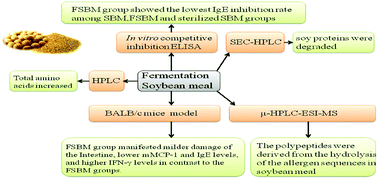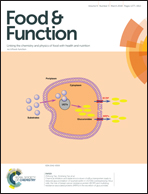Degradation of major allergens and allergenicity reduction of soybean meal through solid-state fermentation with microorganisms
Abstract
In this study, we determined whether solid-state fermentation could degrade major allergens and reduce potential allergenicity of soybean meal (SBM). Solid-state fermentation was realized through a mixture of Lactobacillus casei, yeast, and Bacillus subtilis. High-performance liquid chromatography, size exclusion-high-performance liquid chromatography, and capillary liquid chromatography/tandem mass spectrometry coupled with electrospray ionization were used to examine the total amino acids and molecular weight distribution of the fermented soybean meal (FSBM). In addition, the potential allergenicity of FSBM was assessed by conducting in vitro competitive inhibition ELISA and oral sensitization and challenge of a BALB/c mice model. The results indicated that the total amino acid content increased and soy protein was degraded into polypeptides with low molecular weights that were derived from the hydrolysis of the allergen sequences N232-D383, G253-I265, E169-S215, G68-G98, A365-I375, and V153-A167. Moreover, the FSBM group exhibited a lower in vitro immunoglobulin E (IgE)-binding capacity than the SBM group. The BALB/c model indicated that the FSBM group manifested milder damage to the intestine, lower mMCP-1 and IgE levels, and higher IFN-γ levels as compared to the SBM group. These findings suggested that the potential allergenicity of SBM was reduced by the solid-state fermentation induced by the mixture of Lactobacillus casei, yeast, and Bacillus subtilis.



 Please wait while we load your content...
Please wait while we load your content...